“Working Class” Job Opportunities according to Lowell Sun – 1920 to 2000
The following set of statistical data related to job opportunities, which might have interested my relatives and their acquaintances, are presented for eight job categories, i.e., operative, laborer, hairdresser, bricklayer, plumber, technician, welder and fireman.
This list is certainly not exhaustive with many other categories such as cab driver, short order cook and mortician’s assistant not included. Hopefully, however, it will give the reader a flavor of the times and point out how WW I, the Depression, WW II and the Cold War influenced career choices.
Introduction
The backbone of Lowell’s world-renown, industrial success in the late 1880s through the 1920s had rested firmly on the shoulders of immigrant workers willing to labor in the city’s industrial sweatshops that were owned and managed by Boston-based entrepreneurs and bankers.
Operative – Consideration
Both these industrialists and the lowly, factory operatives were subject to fluctuations in the world marketplace for textiles, which experienced sharp changes in demand in the 1890 to 1910 time period. In the decade of the Great Depression when the local economy was in the dumps, unskilled and semi-skilled workers of the operative class could only expect about 547 new, job openings per month, which represented an improvement over the 374 new openings available per month in the previous decade. Although the work was dangerous and poorly paid the textile labor market still showed some signs of hope for these individuals. But the 1950s and 1960s showed a sharp decline in openings for the labor of the unskilled operative.
But it took the outbreak of WWII with the greatly increased demand for fabric needed for military uniforms, tents and parachute material to brighten the work-a-day environment of the operative. Curiously, Lowell’s established expertise in shoe production needed for GI boots and aviator footwear also brought a ray of sunshine into an otherwise dismal labor environment.
Reflection
In the grand scheme of things, a war happening elsewhere than in one’s own backyard brought more disposable income to the pocketbooks and wallets of the city’s working class inhabitants. As a result, cobblers, pharmacists, barber shops owners, grocers, dairymen and even the Lowell Sun publishing house began to flourish a bit more. Often, my mother told me, years after the end of WWII, that the Depression years were harder to bear in Lowell than the days of the Second World War. As a child, I could not understand her comment.
Detailed Comparisons among Blue Collar Job Categories
Operative
Note: The unskilled and semi-skilled workers in the operative category had been the backbone of the textile industry since the foundation of Lowell’s fabric companies going back to the 1830s. Job opportunities still existed after WWI with an additional demand for such workers up to the start of WWII when US government contracts for military uniforms plus parachute fabric skyrocketed production quotas.
The years from 1940 through 1945 were, according to my mother, very reassuring for Lowell’s operative worker class. Curiously enough, an international conflict can be seen as a blessing from heaven when economic and social disasters threaten folks on the home-front.
&&&&&
Laborer
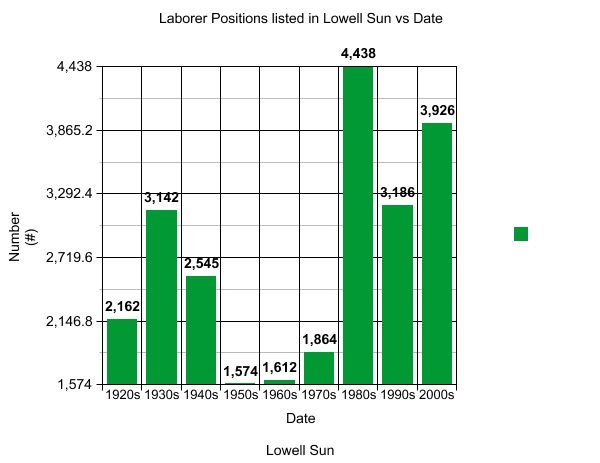
Note: The number of jobs in the laborer category showed considerable fluctuations from the 1920s to the 1950s. For every such job available in the 1950s, there had been two such positions in the 1930s. Local industry was apparently seeking more qualified workers after WWII. However, an apparent economic revival took place in the city in the 1980s and suddenly there went out a call for laborers again.
&&&&&
Hairdresser
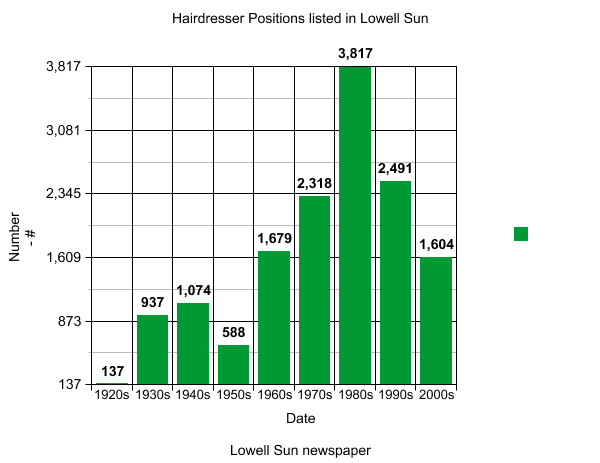
Note: Hairdressing might be considered a reliable barometer for the economic viability of a region. These data (given above) show a modest increase (~15%) in the number of hairdresser jobs from the 1930s to the 1940s followed by a 45% decrease in hairdresser positions from the 1940s to the 1950s, but the situation for hairdressers greatly improved over the next three decades. Again, this information seems to reflect a general financial upswing in the Lowell economy during this later time period.
&&&&&
Bricklayer
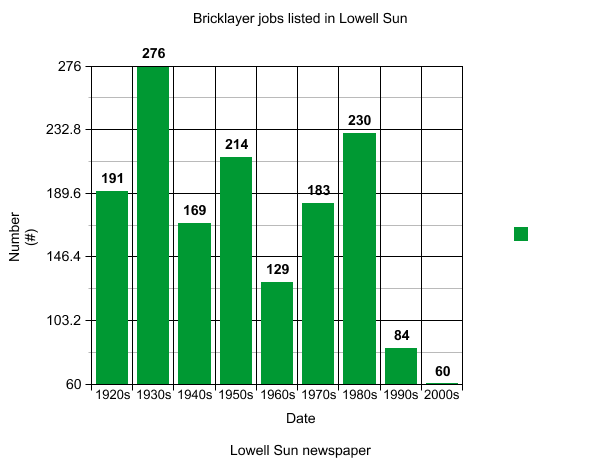
Note: The job of the bricklayer requires a special set of skills that distinguish this worker category from that of other blue collar individuals. In the 1930s during the Great Depression, there went out a call for 3142 laborers in comparison to the 276 calls for a bricklayer. That represents about an 11:1 ratio of marketplace preference for bricklayers to laborers in that time period.
Given that most large-scale, industrial buildings in the city of that period had red and yellow, exterior, supporting walls made of bricks, this fact may not seem difficult to understand by even the casual observer. Again, one’s economic well being in those hard times depended strongly on the technical skills that one could bring to a given work situation. Job destiny favored the prepared worker.
&&&&&
Plumber

Note: Plumbers play an important role in the residential and industrial development of a region since new factories and home sites require the installation of up-to-date conduits for the transport of heat, gas, oil and water within the new structures and between key distribution centers to user sites within the city. During my growing up years in the city, the status of a plumber among the locals was highly esteemed.
A journeyman plumber position meant that the a guy – women were not considered candidates – just might succeed as a key player in life. Being set up trough personal connections in the local union could be seen as an important first step in this career development. The demand for plumbers started to skyrocket in the 1980s because, much new construction took place at that time.
&&&&&
Technician
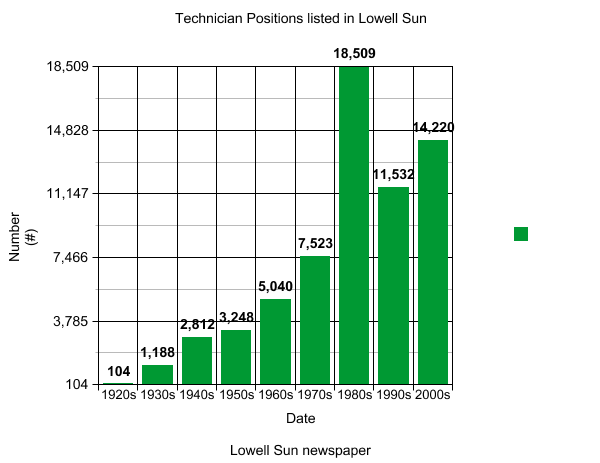
Note: Technician is a generic job description implying that the individual has some technical job qualifications without specifying the industrial sector category in questions. Examples might include dental technician or, perhaps, electronics technician. As seen in the graph above, the number of requests for a “technician” shows an exponential increase from the 1920s through the 1980s. Lowell was gradually becoming more up-to-date in job requirements as the 20th Century trundled through the Cold War and the Space Age.
&&&&&
Welder

Note: Acetylene torches and flip-down metal helmets with a protective see-through optical viewing port were not everyday occurrences in my Centralville section of town in the 1940s to the 1960s. But some auto repair shops might have provided welding services to the customers. However, the Cold War firms in the area, e.g. Raytheon and GE, did use this technology to satisfy job requirements in the building of ground-to-air and, later, air-to-air missiles for the Armed Services.
&&&&&
Fireman
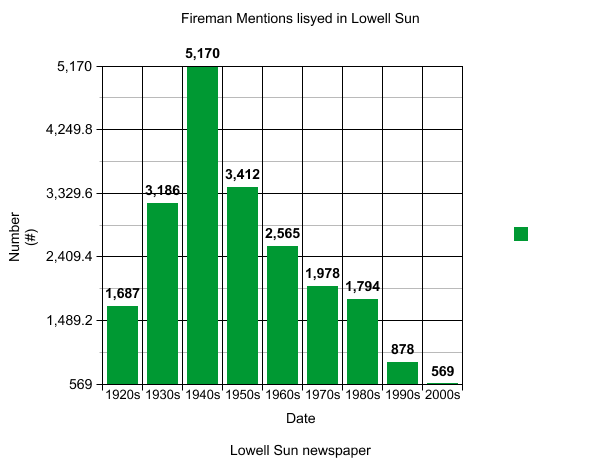
Note: As I understand the situation, the position of fireman was announced in the Lowell Sun classifieds as an opening that was open to candidates, which successfully passed a competitive exam . Usually, there were many more candidates seeking this city position than available job slots. During the Depression, being selected
&&&&&
In closing, the reader may also be interested in the employment possibilities available to people classified as professionals. Some of these job openings are listed in the next article.

